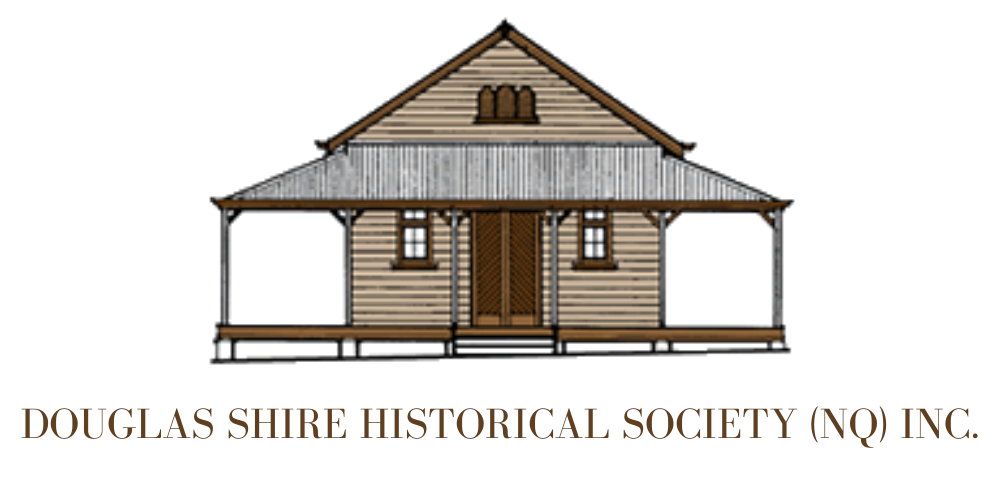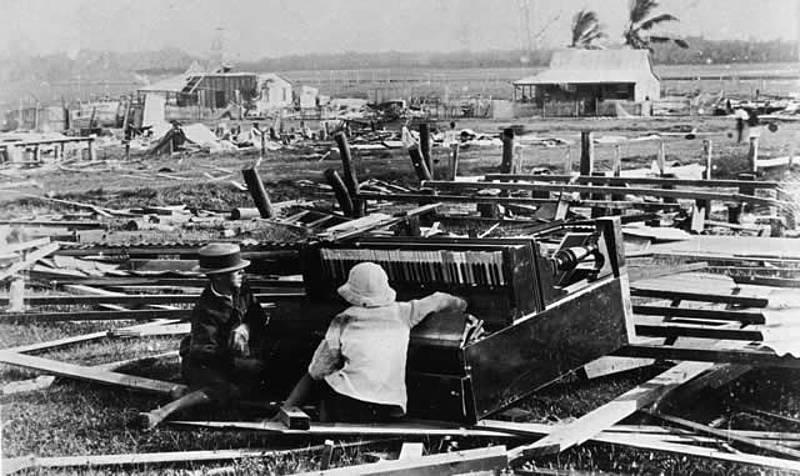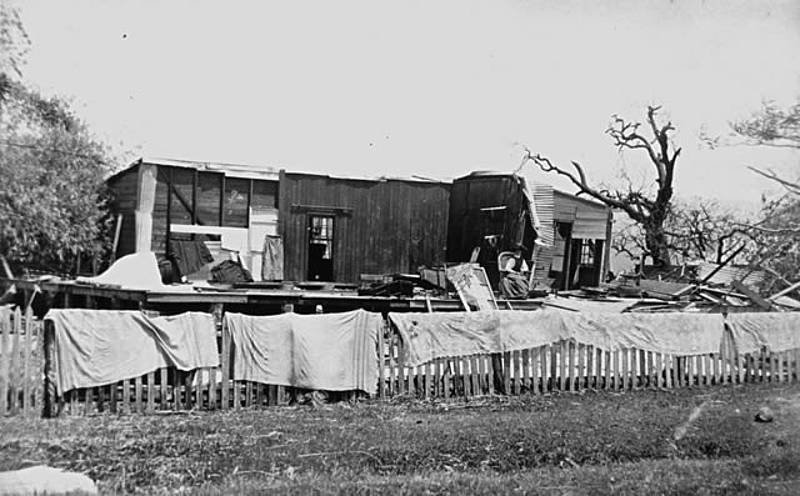The Cyclone of 1911
On March 16, 1911, the second cyclone in five weeks and one of the worst cyclones on record hit Port Douglas and Mossman.
Port Douglas
Within 24 hours, 16 inches of rain fell. Most buildings were damaged. Many were never rebuilt because of the town’s uncertain future. Two people were killed: 32 year old Timothy O’Brien and Andrew Jack (both buried in the Port Douglas cemetery).
Winds were up to 216 kph. Port Douglas entirely flattened but for about seven partly standing homes, the Qld National Bank, the Customs House, the Post Office and McLeans’s Hotel. A report from the Brisbane Courier on March 22, 1911 states about 40 people took refuge in the town’s Government Bond building on account of its apparent structural integrity. (Cairns Post 2 Feb 2019)
“The faith placed in the stability of the building, however, was not justified, for the occupants (numbering 40) had just taken timely warning from its nerve-shaking tremors and emerged from the doorway to reach the fence round the Customs building, when the bond store collapsed” it continued.
Only 7 out of 57 houses were left standing with 100 persons left homeless. There was similar damage at Mossman. (BOM)
Among others, the Chinese Joss House, the cordial factory and the Oddfellows Hall were destroyed, and the school and hospital lost their roofs. All the small boats in the inlet were lost.
Andrew Jack was a pioneer of the Killaloe district. His house collapsed on him. He was had been on the Shire Council between 1903-1906 and since Feb 1909. His widow survived him by only three months, leaving 8 children including 8 year old twin girls.
Tim O’Brien, an accountant and one of two living sons and a daughter of the Macrossan Street bootmaker, John O’Brien was helping his mother Margaret across the street to the National Bank building and was struck by flying debris.
(Sarah) Phoebe May, six years old, was given up for dead. She had her face gashed by a sheet of iron and was scarred for life. In 1930 she married Arthur Daintree Osborne.
Mrs Bridget Tait’s North Australian Hotel was rebuilt as a two-storey hotel. Some of it survives today as the Central Hotel.
Mrs J.D. Crosbie’s Court House Hotel (formerly Buchanan’s Family Hotel) with its single storey was extensively damaged. The new two-storey Court House Hotel was built on the adjacent block where it is today, although the old Family Hotel was repaired and used in a limited capacity until 1961, when it was condemned and not used further. It was moved to an adjacent lot and ‘last drinks’ were finally called on 24th November 1977.
Sampson’s two-storey Exchange Hotel lost the greater part of its roof and was rebuilt as a single storey hotel.
Bob McLean’s (Robert) Caledonian Hotel was unroofed and its brick chimney destroyed but it was the least damaged of all the pubs and was the only one to have its licence renewed in April. Most of the photos of the cyclone damage were taken from its upper storey. It was repaired, maintaining its two-storeys, and its hall was erected on the opposite side of Warner St.
The Port Douglas Court House was blown off its stumps. In its repair it was lifted and rotated 90 degrees and put on higher ground to secure it to the new shorter and more firmly located supports.
Walsh and Co’s store was completely demolished. They did not rebuild but carried on in rented premises next to the North Australian Hotel and finally in the large hall belonging to the Caledonian Hotel in Warner St. The cyclone and ill-health in the family were the major factors that caused the firm to go out of business.
St Mary’s Catholic church and presbytery were destroyed. Fr Patrick Crotty, parish priest, telegrammed St Monica’s in Cairns to say ‘presbytery and both churches absolutely levelled” (this means Mossman also). By May the presbytery was rebuilt in Port Douglas using salvaged timber by Sargent & Son of Mareeba. It also served as a chapel until the new church was built, starting in 1913.
St Mary's church was moved to the waterfront Park in 1988 to become St Mary’s by the Sea.
The original wooden Island Point lighthouse was blown over. It was quickly re-erected on a hexagonal concrete base and the lighting apparatus, having been thoroughly repaired, worked satisfactorily. It was replaced in the 1930s and was in the first group to be converted to an automatic light replacing the need for a light keeper. The lighthouse has not been used since the 1990s. A beacon has been located on communications tower further up the hill.
St Andrews By the Sea Church of England in Davidson Street was blown over. In July a design by Rev Taffs for a new smaller timber church in Wharf Street, on the Solomon’s store site, was accepted by the Parish Council and Mr Nielsen began building the church and a cottage. The first service at the new St Andrews by the Sea, conducted by Bishop White occurred on 19 November 1911.
The office of the Port Douglas and Mossman Record, managed by F. Thompson, price threepence, issued weekly. was destroyed, but it continued until 1913.
Many buildings were never rebuilt because of the town’s uncertain future.
Cairns Post Friday 31 May 1912
There is no doubt that the town of Port Douglas now presents a better appearance than ever it did before the cyclone of March, 16th 1911, says the ''Record" Even the sign-board have renovated by Mr. A S. Hannan of Cairns. Mr John McLean who surprisingly relinquished the occupancy of the Caledonian Hotel, and bought what was known as Poney's allotment on the opposite corner, has had that cottage enlarged and renovated, and has taken up his residence there. Messrs. W. Robertson and C. Tunnie were entrusted with the work, which they have evidently carried out well. The cottage was lifted and moved about 40 feet towards Mr. J. McD. Ramsay's shop, raised two feet on the blocks, and two back rooms, a kitchen, and big stables built and the cottage nicely Painted.
(This building is now Salsa Bar & Grill)
Mossman & district
Mar 16. The Exchange Hotel, Callaghan Walsh’s store, the Mossman Butcher shop and Lunn’s Coronation Hall were damaged as well as many homes and farms. The Catholic and Anglican timber churches were destroyed. The sugar Mill was badly damaged and the manager’s quarters and men’s quarters were destroyed.
St David’s timber church was destroyed . Services were held in the Reading Room/hall, until the stone St David's was ready in 1952. The hall was demolished in 1955. Within two weeks of the cyclone, a flood washed away the floor of St David’s church hall and the furniture and timber from the church that had been stacked there.
Fr Patrick Crotty, parish priest, telegrammed St Monica’s in Cairns to say ‘presbytery and both churches absolutely levelled” (this means the timber Catholic church of St Augustine's in Junction Road Mossman, built in 1905, and St Mary’s church and presbytery in Port Douglas). Within 11 months the Catholics in Mossman had a new timber church,. It included new structural features to make it more resilient in cyclones.
The Exchange was rebuilt as a graceful two-storey building.
The Coronation Hall was immediately re-erected and used for a function in July.
This cyclone took the roof off the Shannonvale homestead and caused the South Mossman river to rise to the floor.
In October the Miallo School began, constructed from timbers from the Rutherford dairy house which had blown down in the cyclone.
Mowbray
A cyclone devastated the area, the second “blow” within 5 weeks. The Stewart family home was flattened. They moved to a temporary shack.
The Mowbray branch of the tramway was badly damaged. Six spans of the Mowbray river bridge were washed away.
In April, a large flood washed away the Trezise home at Spring Creek, their outbuildings and half of their citrus orchard.
In 1915 a severe drought made the fallen timber from the 1911 cyclone very dry and bushfires burnt kauri pine and hickory. Farmers in Spring Creek spent a week trying to put out a fire.
A sheet of corrugated roofing iron has been wrapped around a pole and behind the two boys are piles of additional debris created by the cyclone. (Description supplied with photograph)
After the cyclone. View from McLean's Hotel Caledonian.
Two children sitting with a badly damaged piano amongst the debris from the Port Douglas cyclone of 1911.
Family stories suggest that the piano belonged to the O’Brien family.
A dead horse and damage to the Port Douglas Court House as a result of the cyclone of 16 March 1911 (Heaslop–Douglas Shire Council Collection)
Mahoney's residence after 1911 cyclone. A woman sits in a chair on what may have been the verandah of the partially demolished house. Blankets and sheets are draped over a paling fence in the foreground of the image.
Millet's railway bridge in Mossman damaged by the 1911 cyclone.
Image shows the wreckage of timber buildings in Port Douglas following the devastating cyclone of 1911. Amongst the debris a brick chimney stack remains intact. For a detailed description of the damage see the Queenslander, 25 March, 1911, p.37. The cyclone struck Port Douglas on the 16th March 1911. Two lives were lost and most buildings in the town were levelled. Only seven out of fifty-seven houses were left standing with one hundred persons left homeless. Information taken from: Tropical cyclone impacts along the Australian east coast from November to April 1858 to 2000
Two men and a boy examine an eight foot sheet of corrugated iron embedded in the ground to a depth of 3 ft, 6 inches by the cyclone. Note repairs already effected to Crosbie's Hotel in the background. [Description supplied with photograph]







